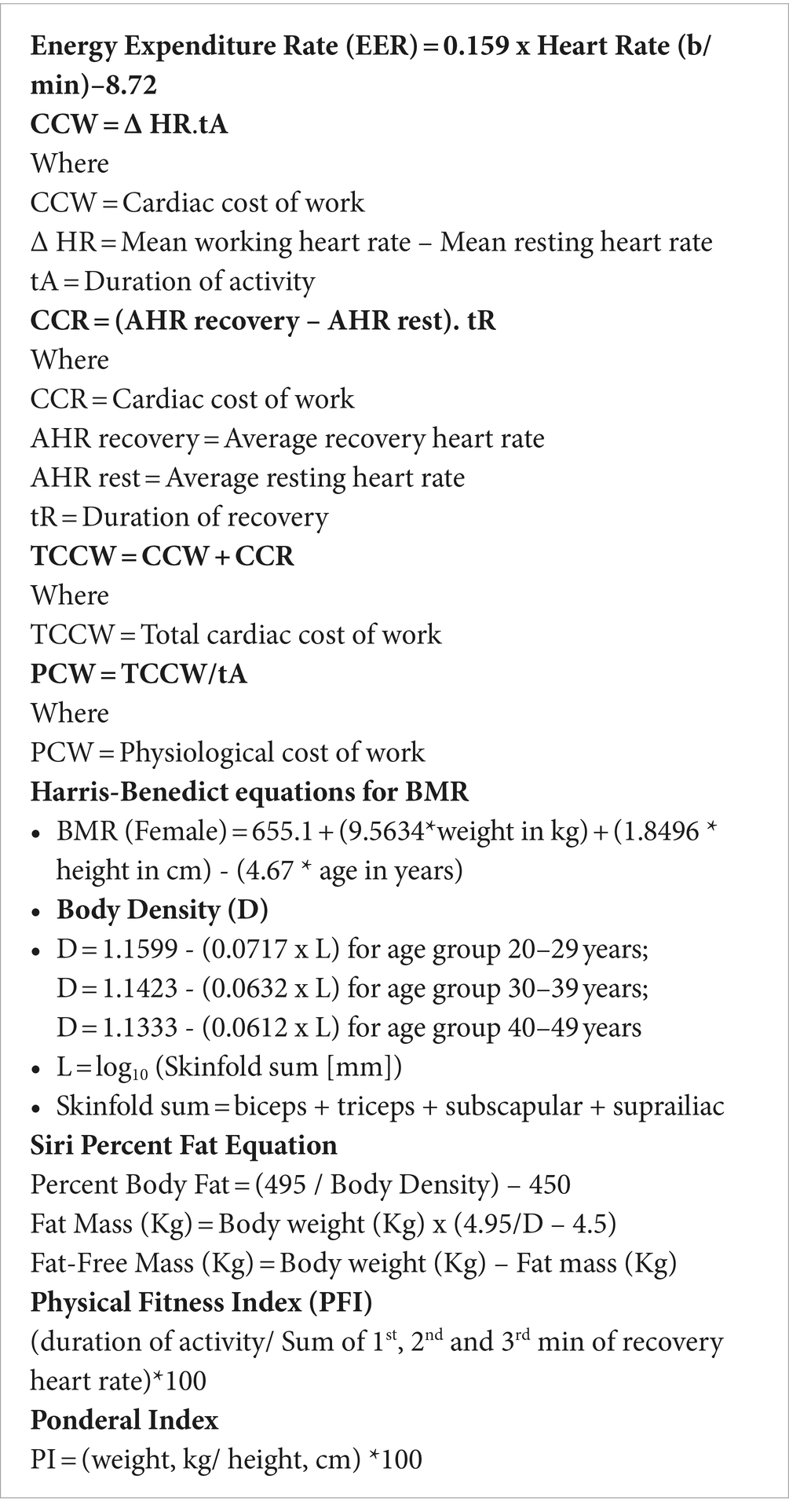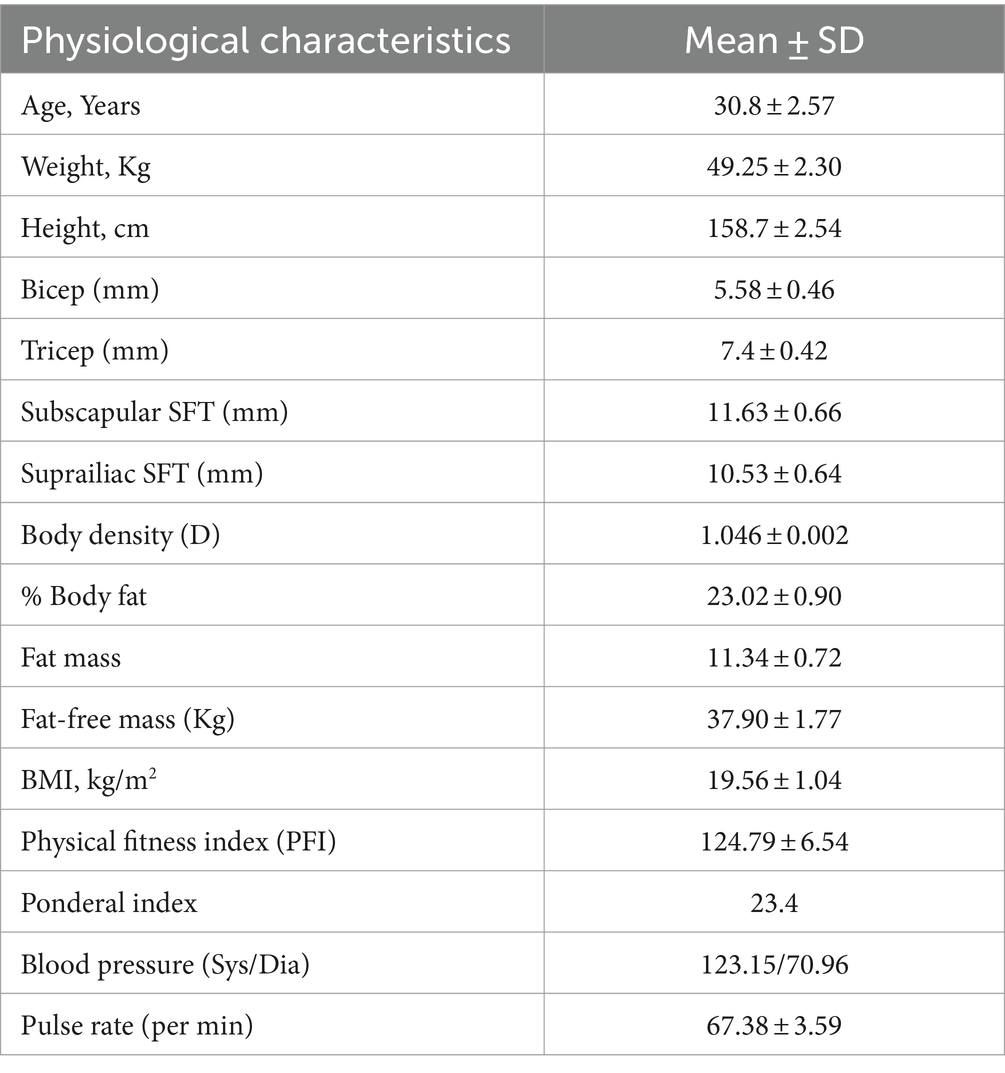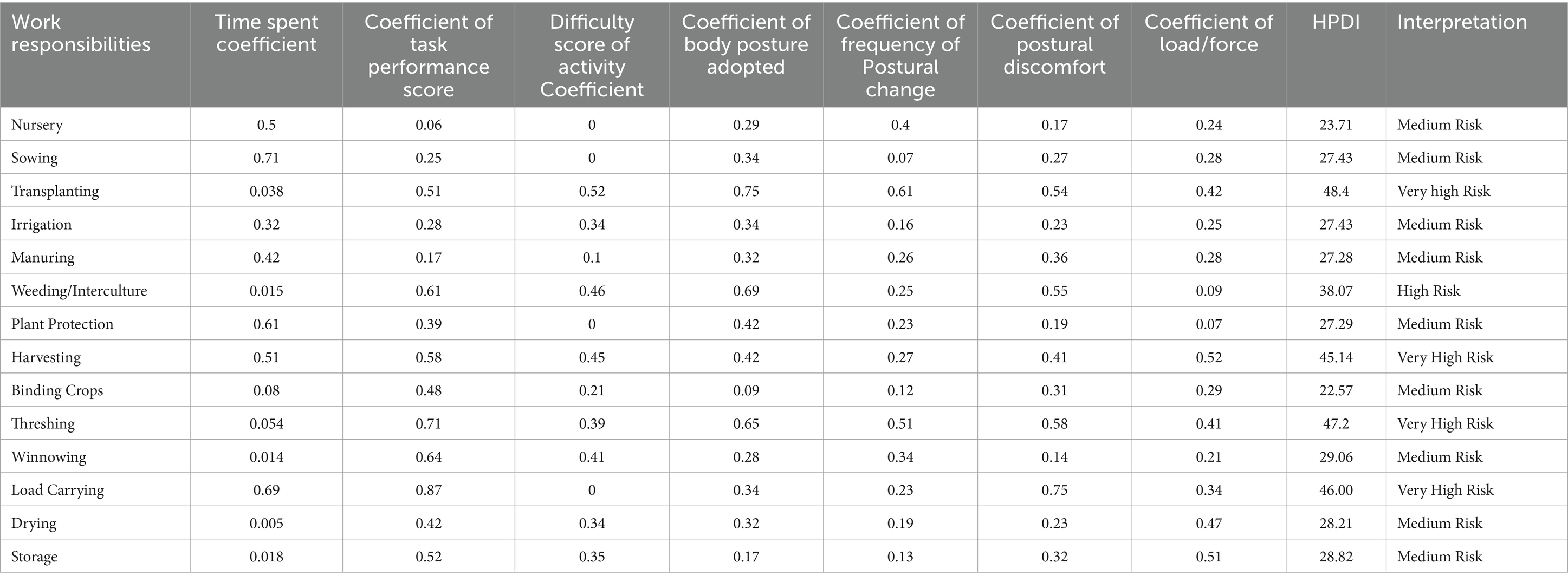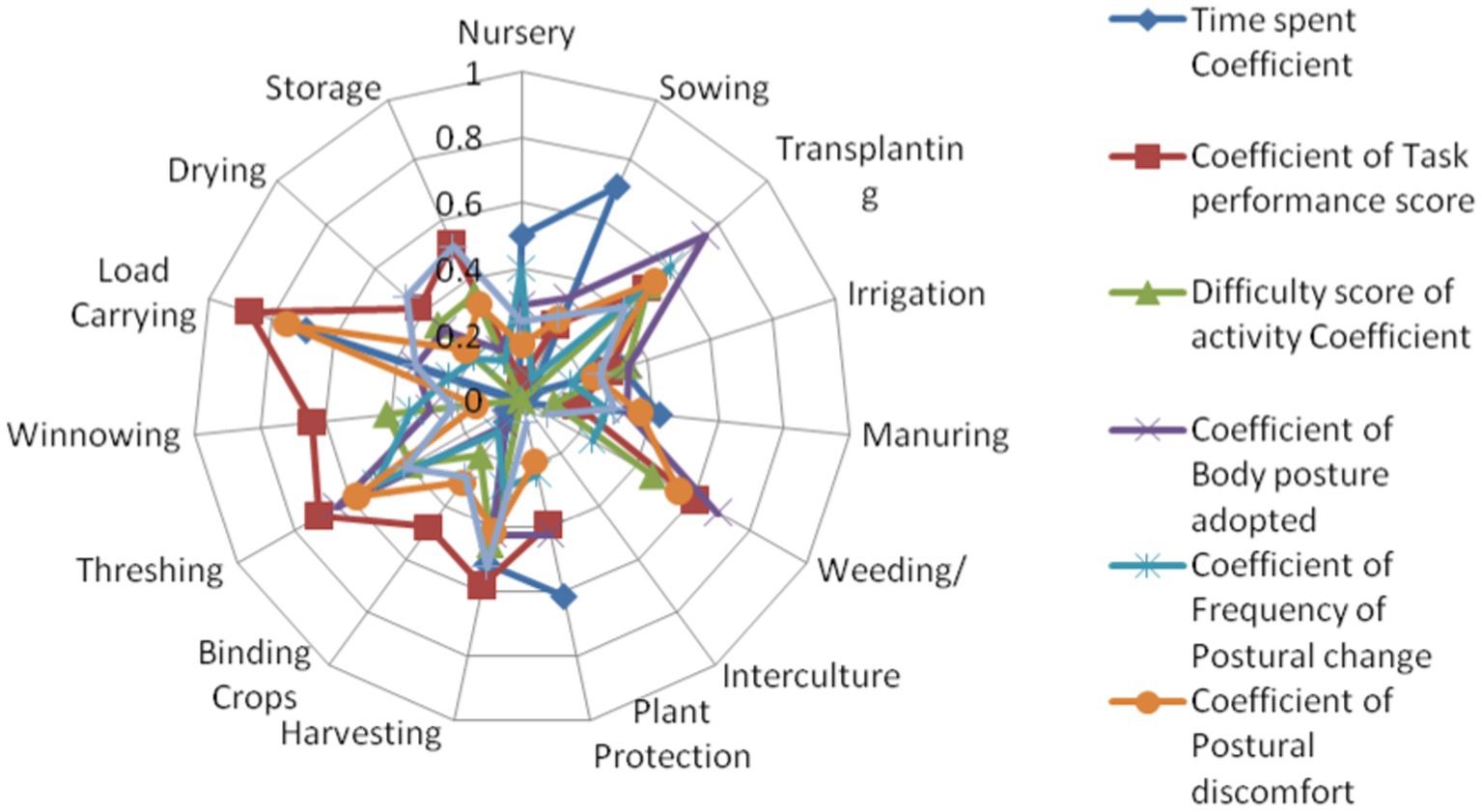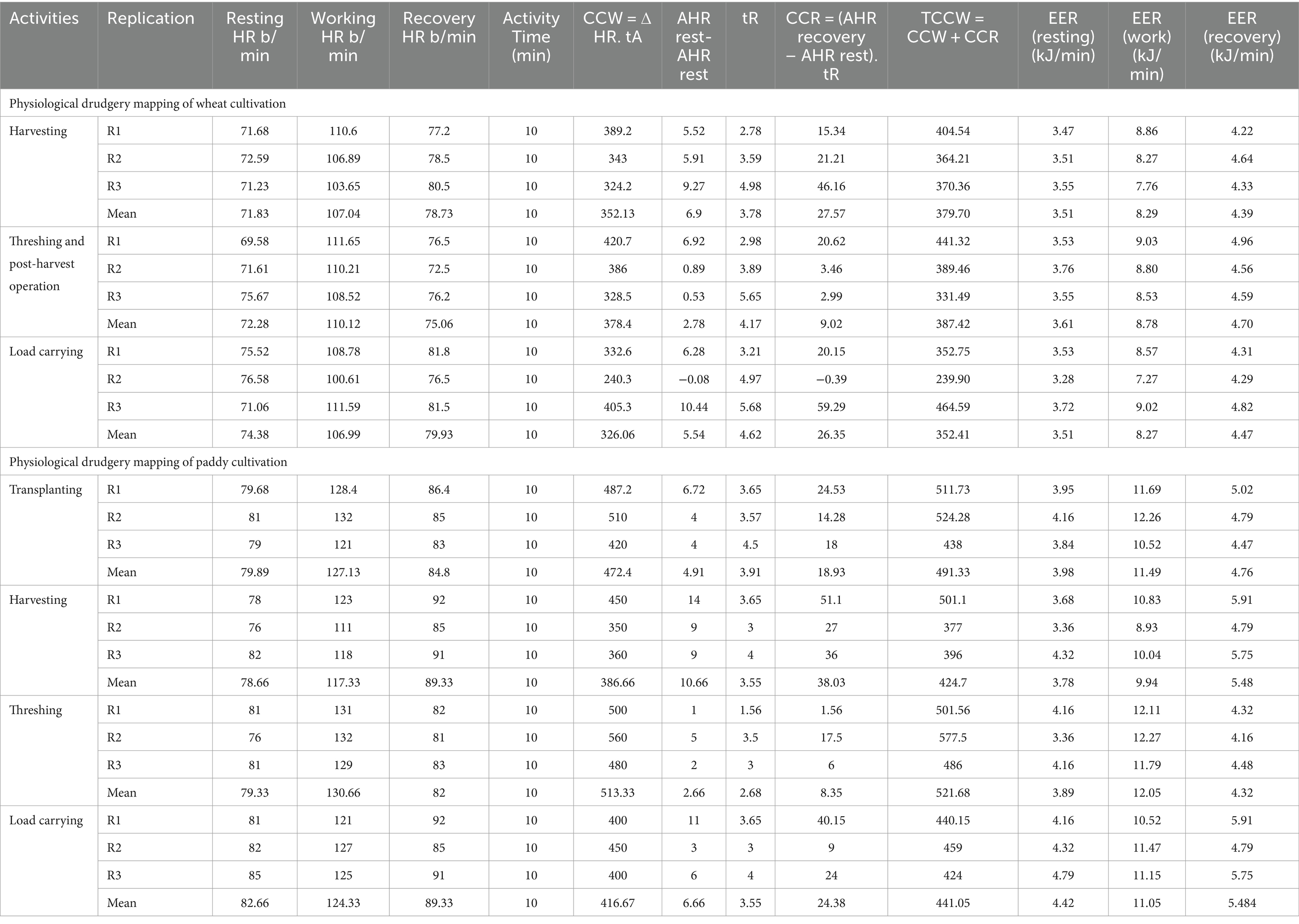- 1ICAR-Indian Agricultural Research Institute, New Delhi, India
- 2ICAR-Directorate of Coldwater Fisheries Research, Bhimtal, Uttarakhand, India
- 3Division of Agricultural Extension, Indian Council of Agricultural Research, New Delhi, India
Farm women are often forced to work in extremely hazardous conditions due to their limited access to improved agricultural technologies. This circumstance makes agricultural work physically demanding, requiring significant physiological effort and the maintenance of good posture. It is also very exhausting, time-consuming, and stressful. The study was designed to evaluate and quantify the drudgery involved in the rice-wheat production system for rural women. Three replications of a 10-min work cycle without a break were used to assess the physiological and postural demands of various farm tasks on the female workers. Observations were recorded on farm women workers who were in normal health, without any major illness, and regularly involved in farm operations. In the attempt to obtain and analyze the prioritized drudgery experiences in crop production activities through drudgery assessment and reduction, various ergonomically sound farm tools and implements were provided for crop cultivation and intercultural operations. Data indicating musculoskeletal disorders were analyzed by ergonomics assessment of postural and biomechanical assessments using the Human Physical Drudgery Index (HPDI), resulting in the maximum drudgery reflecting very high risk in transplanting (48.4%), followed by threshing (47.2%), load carrying (46.00%), and harvesting (45.14%). For physiological ergonomics quantifications, the most drudgery-prone activities in the rice-wheat production system, i.e., transplanting, harvesting, threshing & post-harvest, and load carrying, were evaluated, and it was found that drudgery is caused by different activities with reflects working energy expenditure rate ranging from ~7.00 to 12.00 (kJ/min) and total cardiac cost of work (TCCW) ~ 331.00 to 524.00. Multivariate regression analysis was employed to drive relationships between energy expenditure rate (dependent variable) and other independent variables, such as age, body mass index (BMI), mid-upper arm circumference (MUAC), calf circumference (CC), skinfold measurements, body density (D), % body fat, fat mass, and fat-free mass (kg). It was found that energy expenditure rate during various crop production practices is positively correlated with independent variables (R = 0.721, R2 = 0.520, Adjusted R2 = 0.518, Standard Error of Estimate = 0.0324, Durbin-Watson = 1.531). It was found that with higher physiological parameters, the corresponding energy expenditure is maximized relating to the drudgery in respective agricultural activities. The present study addressed the magnitude of drudgery for women farmers in the rice-wheat production system and its mitigation strategy.
1 Introduction
Agriculture is not only India’s main source of income but also its way of living. Men and women both play a vital role in the world’s food supply (Cathy et al., 2022). Researchers highlighted the agricultural feminization processes determining the role of women in the wheat-based farming systems in the Indo-Gangetic Plains of India (Jyotsana et al., 2005; Joshi et al., 2018; Anusha and Mehta, 2021). In recent years, there has been a significant focus by development agencies on mainstreaming and empowering rural women (Jadhav, 2020). Many of the agricultural tasks require high levels of physical effort. Investing in the health of agricultural workers would be a humanitarian and economic decision (National Institute for Occupational Safety and Health, 2001; Gautam et al., 2020; Joshi et al., 2020). The rice-wheat cropping system (RWCS) plays a vital role in global food security as it provides staple foods to the world’s population (Lalik et al., 2014; Banjara et al., 2021). Human energy is essential to survival in the rural production system. Declining agricultural profits from farming have resulted in lower use of labor and increasing casualization of labor, particularly female labor (Jafry, 2016). Women contribute to agricultural activities significantly, and their tasks are the most difficult and strenuous ones. In various surveys related to women’s contribution toward agriculture, mostly time and monetary parts are calculated (Kumari, 2015).
Paddy and wheat are important cereal crops and are grown in almost every country of the world (Ahmad et al., 2021; Sharma et al., 2022). Wheat and paddy cultivation practices demand high labor and are directly associated with human drudgery. Major labor-intensive processes in agricultural work are transplantation, weeding, harvesting, threshing, and load carrying, and farm women are engaged in the most tedious and back-breaking tasks in crop fields (Karki et al., 2012). Traditionally, women were using manually operated farm tools and equipment. These activities not only require maximum physical effort but also require energy expenditure due to the high level of drudgery in some of the farm activities. This leads to health issues and has a negative impact on efficiency as it reduces the output of the activity. In addition to other inputs in agriculture, human labor is also a major resource/factor in production by performing field operations. Human effort provides over 70% of the energy required to produce crops (Prabhakar et al., 2023). The main reason for their suffering is a lack of knowledge about modern technologies and age-old ways of doing work. The weight of work and related health problems have a deep impact on productivity and the economic and social welfare of workers. Because they perform a wide range of tasks related to agriculture, housework, and other activities from dawn to dusk, they shoulder a lot of responsibility and adopt many unnatural postures that increase cardiovascular stress and musculoskeletal disorders (Klasen and Lamanna, 2009; Kumar et al., 2011). Although they have not been formally identified or quantified, these physically demanding agricultural tasks are sources of drudgery. Agricultural women work in extremely arduous conditions that stress them out physically and mentally because they lack access to improved agricultural technologies. Agricultural activities are among the drudgery-prone jobs that demand both physical and psychological energy being difficult, tiring, and stressful. Workers end up in stagnant, repetitive, and frequently neo-neutral postures that lack support due to poor working conditions and lack of technological advancement (Kuiper et al., 1999; Vuuren et al., 2005). Women are expected to perform heavy work in crop production, which includes bending over for extended periods of time, jerking movements while threshing, cuts and bruises while harvesting, and carrying loads on the head, back, and shoulders. These unfavorable working conditions are taxing on women’s health. In a study, it was reported that tasks involving lumber flexion or extended postures for long (manual weeding, harvesting, and threshing) are relatively common (Boocock et al., 1994) and may incur moderately high compressive loads on the lumbar spine and are a potential source of occupationally related back injuries and hazards (Hoy et al., 2014). Injuries, including low back pain and spine problems in workers during work, have been recognized as a main contributory factor (Kamarudin et al., 2013). The present study will highlight the following researchable issues:
• What are the causative factors for drudgery and its magnitude faced by women farmers in the rice-wheat production system?
• How to quantify and map drudgery for physiological and postural ergonomics assessment?
• What are the mitigation strategies for hazards and drudgery encountered by women farmers?
2 Materials and methods
The study was conducted in two phases. In Phase I, an exploratory research design was used for data collection of the human physical drudgery index accompanying 100 farm women (50 farm women for wheat and 50 farm women for paddy cultivation practices) with a random sampling technique. In Phase II, experimental data were recorded on the maximum drudgery-prone activities of agricultural operation (specifically wheat crop in Rabi and paddy crop in Kharif) identified as per the procedure for the Human Physical Drudgery Index. For the experiment, a total of 10 farm women each for wheat and paddy cultivation were in the age group of 25–45 years, non-pregnant, non-lactating, and had no history of acute or chronic illness or cardiovascular diseases for 2 years. Three replications of a 10-min work cycle without a break were used to assess the physiological and postural demands of various farm tasks on the female workers with a random sampling technique. The agricultural cultivation practices in paddy-wheat cropping patterns were evaluated based on physiological and psychological ergonomics parameters, viz. heart rate, blood pressure, energy expenditure rate, total cardiac cost of work, physiological cost of work, blood pressure, and perceived stress (Table 1).
2.1 Phase I: quantification of drudgery based on the human physical drudgery index
The Human Physical Drudgery Index (Kundu et al., 2021) can be calculated based on a linear combination method using the scores obtained from time spent on the activity, task performance score, difficulty score of the activity, body posture adopted, frequency of postural change, load/force, and postural discomfort.
• Step I- Time spent (h/year) = time in h/day x total no of days performed in a year
• Step II- Task performance score (in Season)
1–2 times - 1, 3–4 times-2, 5–6 times −3, 6–7 times −4, > 7 times −5
• Step III- Difficulty score of activity
Most difficult −5, difficult- 4, neutral- 3, easy- 2, and very easy-1
• Step IV- Body posture adopted
Upright-1, trunk flexion/extension 0–200-2, trunk flexion 20-600/extension >200–3, trunk flexion >600–4 (Additional scores if back twisted +1, squatting/stooping +1, one or more body parts are static for longer than 1 min +1, repetition of activity +1)
• Step V- Frequency of Postural change (number of times posture changes)
1–3 times- 1, 4–6 times- 2, 7–9 times-3, and > 9 times
• Step VI- Postural discomfort (pain/numbness/tingling in body parts)
Very severe-5, Severe- 4, Moderate-3, Light-2, and Very Light-1
• Step VII- Load/force
0–5 kg-score 1, 5–10 kg-score 2, 10–15 kg-score 3, 15–20 kg score-4, >20 kg-5.
Based on the coefficient of each parameter, HPDI is calculated and categorized into various action levels for assessment of occupational risk and drudgery with the following formula:
2.2 Phase II: physiological ergonomics evaluation of drudgery in rice wheat production system
In the second phase, the physiological parameters viz. body mass index (BMI), total energy expenditure (TEE), basal metabolic rate (BMR), energy expenditure rate (EER), total cardiac cost of work (TCCW), and physiological cost of work have to be calculated for physiological and biomechanical assessment of agricultural activities in paddy-wheat cropping pattern. The threshold level of physical workload based on physiological variables has been taken (Nag and Chatterjee, 1981) as a criterion for defining workload. Table 2 details the range of physical workload and corresponding physiological parameters.
Circulatory stress was evaluated from the cardiac cost of work and the cardiac cost of recovery. The cardiac cost of recovery is the total number of heartbeats above the resting level occurring between the end of the work and the return to the resting state. During the second phase, initially, the resting heart rate (HR)/min for 5 min was recorded. Women were then given rest and recorded the recovery heart rate/min and RPE for a minimum of 10 min or till complete recovery. The body mass index (BMI) was calculated by dividing the square of height (m) by the body weight (kg) of subjects. Based on the body weight of subjects, aerobic capacity was estimated using the following general equation (Singh et al., 2008):
The cutoff value was selected as the working heart rate corresponding to the 33% level of maximum aerobic power (i.e., VO2 max.) of the Indian population (Maiti and Ray, 2004), which was equivalent to a heart rate of 101.6 beats.min−1.
A polar heart rate monitor was used for recording the heart rate of subjects during the course of the study. Data for resting and working were taken for the period of 10 min. The oxygen consumption of subjects on their measured heart rate was estimated based on the following general equation (Singh et al., 2008):
Where Y = oxygen consumption, l/min; X = heart rate. The energy expenditure was calculated using 1 L oxygen, equivalent to 20.93 kJ.
The following formulae were used to calculate the total cardiac cost of work (TCCW) and physiological cost of work (PCW):
3 Results
3.1 Physiological characteristics of respondents
The physiological characteristics of farm women selected based on the physical fitness index for ergonomics assessment of rice-wheat cultivation practices are given in Table 3. As per the physiological characteristics of the subjects, the mean age of the subjects was 30.8 years with ±2.57 standard deviation. The corresponding physiological parameters recorded as height 158.7 ± 2.54 (cm), bicep 5.58 ± 0.46 (mm), tricep 7.4 ± 0.42 (mm), subscapular skin fold thickness (SFT) 11.63 ± 0.66 (mm), suprailiac SFT 10.53 ± 0.64 (mm), body density (D) 1.046 ± 0.002, % body fat 23.02 ± 0.90, fat mass 11.34 ± 0.72, fat-free mass (Kg) 37.90 ± 1.77, BMI, kg/m2 19.56 ± 1.04, physical fitness index (PFI) 124.79 ± 6.54, ponderal index 23.4, blood pressure (Sys/Dia) 123.15/70.96, and pulse rate (per min) 67.38 ± 3.59.
3.2 Drudgery assessment of farmers while agricultural operations
Various postural ergonomics techniques were used to quantify musculoskeletal issues using traditional methods and postural evaluation of farm women while performing various agricultural activities. The Human Physical Drudgery Index (Kundu et al., 2021) was calculated for cultivation practices viz. nursery raising, sowing, transplanting, irrigation, manuring, weeding and intercultural operations, plant protection, harvesting, binding crops, threshing, winnowing, drying, and storage for postural assessment. It can be observed from Table 4 that the maximum drudgery reflecting very high risk based on HPDI was found in transplanting (48.4%), followed by threshing (47.2%), load carrying (46.00%), and harvesting (45.14%).
3.2.1 Discussion
In the present study, the associated risk and causative factor for drudgery mapping as per HPDI were calculated, and very high risk was found in transplanting, threshing, load carrying, and harvesting operations in the agricultural domain based on stressors such as time spent, difficulty, posture, frequency of change in posture, associated discomfort, and load carried. Therefore, these most drudgery-prone activities were taken for further evaluation of physiological ergonomics. However, nursery raising, sowing, irrigation, manuring, plant protection, binding crops, winnowing, drying, and storage were under moderate risk with an associated ~20–30% range of HPDI categorization (Table 4).
Data regarding causative factors shown in Figure 1 reflect that in nursery raising activity, time spent, body posture adopted, frequency of postural change, and postural discomfort are the major causes of drudgery with a corresponding HPDI of 23.71% (Table 4). For sowing activity time spent, task performance score, body posture adopted, and postural discomfort are the stressors; however, transplanting was under very high-risk tertiles corresponding to posture adopted, frequent changes in posture, associated discomfort, task performance, etc. In irrigation, manuring, plant protection, binding crops, winnowing, drying, and storage activities, the medium risk category corresponding to the coefficients of each causative factor was less than 0.65. In a study (Dubey et al., 2019), it was documented that the female was asked about discomforts faced after performing the harvesting activity, faced pain, numbness, stiffness, and tingling sensation in different body parts corresponding to the risk factors associated with the harvesting activity that would develop into musculoskeletal disorder if left untreated and unattended.
3.3 Physiological drudgery mapping of wheat cultivation practices
For ergonomics quantifications, the three most drudgery-prone activities in the wheat production system (Phase II), i.e., harvesting, threshing, and post-harvest operation and load carrying, were evaluated based on physiological ergonomics parameters (Table 5) viz. heart rate (b/min in resting, working, and recovery phase), energy expenditure rate (kJ/min), cardiac cost of work, cardiac cost of recovery, physiological cost of work, etc. In threshing and post-harvest operation, the mean heart rate increased up to 107.04 beats/min (EER 8.29 kJ/min) from 71.83 beats/min (EER 3.51 kJ/min) from the resting heart rate corresponding to the moderate threshold level of physical workload (Table 2). In the harvesting of wheat crops, the resting heart rate was ~72.0 b/min, which shoots in the range of 103–110 b/min with ~8.0 kJ/min energy expenditure rate in 3 replications, which also reflects the moderate threshold level of physical workload. However, threshing and post-harvest operation were found to be the most drudgery prone, with EER ranging from 8.0 to 9.0 kJ/min, along with total cardiac cost of work and physiological cost of work. In the load carried after threshing activity, a resting heart rate of 71.0–76.5 b/min increased up to 100.00–111.59 b/min with associated EER of 7.27–9.02 (kJ/min), TCCW 1006.0–1115.9 beats, and PCW 20.15–59.29.
3.3.1 Discussion
In the present study, as per the threshold level of physical workload, all three major activities, viz. harvesting, threshing/post-harvest operations, and load carrying in the wheat production system, were moderate based on heart rate and energy expenditure rate during the experiment. It was documented in a study that paddy/wheat harvesting in hot climates causes a considerable cardio-respiratory and thermo-regulatory strain. The physical strain and fatigue might result in accidents and injuries, and therefore, the work levels that may be maintained daily on a regular basis should be optimized; it is suggested that the work levels for 8 hourly activities for men and women should not exceed beyond 35 and 28% of one’s aerobic capacity (Nag and Nag, 2004).
3.4 Physiological drudgery mapping of paddy cultivation practices
For ergonomics quantification of drudgery paddy cultivation practices (Phase II), viz. transplanting, harvesting, threshing, and load carrying activities were evaluated based on physiological ergonomics parameters. Transplanting is a tedious operation typically performed by women, who work in an upright bending posture. A woman may have to dip her hand 6,000–7,000 times to transplant paddy seedlings in standing water. This posture, when continued for years together, results in low back pain (LBP) and spinal disorders. Data depicted in Table 5 for transplanting activity by the traditional method, mean resting heart rate of 79.89 b/min increased up to 127.13 b/min with associated EER 11.49 (kJ/min), TCCW 491.33 beats, and PCW ~49, which correspond to the heavy threshold level of physical workload (Table 2). Harvesting is one of the most labor-consuming operations in farming. For harvesting activity, the resting heart rate of 78.66 b/min increased up to 117.33 b/min with associated EER 9.94 (kJ/min) and area coverage of 0.05 ha/day. The value of the total cardiac cost of work during the experiment for harvesting was 521.68 beats and the physiological cost of work was 52.17. Threshing operation in paddy cultivation was found to be a tedious practice that is normally performed by farm women (Dasa and Gangopadhyay, 2011) in prolonged bending posture (Larson and Hannihen., 1995) by beating harvested paddy bundle on wooden plank/drum, etc., with repetitive motion. This posture adopted for this practice and jerking moment in the long run results in low back pain (LBP) and musculoskeletal disorder (Murthy and Bindu, 2013). The results are in line with the study (Nayak et al., 2022), which mentioned that farm women undergo hard physical drudgery, especially while transplanting rice in the mud with a bending position for a long time.
For paddy, the threshing operation was found to be the most drudgery prone, with mean heart rate increasing up to 130.66 beats/min (EER 12.05 kJ/min) from 79.33 beats/min (EER 3.89 kJ/min), from resting heart rate corresponding to a heavy threshold level of physical workload. In the load carried after threshing activity, the resting heart rate of 82.66 b/min increased up to 124.33 b/min with associated EER of 11.05 (kJ/min) and TCCW 441.05 beats refereeing to the heavy threshold level of physical workload.
3.4.1 Discussion
In the experiment, as per the threshold level of physical workload, all three major activities, viz. transplanting, threshing, and load carrying activities in the paddy production system, were heavy; however, harvesting was moderate based on heart rate and energy expenditure rate during the experiment. Researchers (Singh, 2012; Awasthi et al., 2018; Anitha et al., 2019) opined that technologies must be designed with the anthropometric measurements of women farmers in mind, which eliminates bending and squatting postures and putting the load on lumber extremities (National Research Council and Institute of Medicine, 2001).
In wheat and paddy production systems, paddy cultivation practices were found to be more drudgery prone, corresponding to a high energy expenditure rate and other circulatory stress corresponding to research opinion in line with the present study to adopt bending and sitting posture during manual uprooting and transplanting (Nawi et al., 2012; Ojha and Kwatra, 2012; Badodiya et al., 2014).
Table 6 presents the determinants of drudgery mapping in relation to energy expenditure rate in crop production practices. Further relationship between high energy expenditure rate and other independent variables such as age, BMI, MUAC, CC, bicep (mm), tricep (mm), subscapular SFT (mm), suprailiac SFT (mm), body density (D), % body fat, fat mass, and fat-free mass (Kg) were also analyzed, and it was found that energy expenditure during activity is positively correlated with variables.
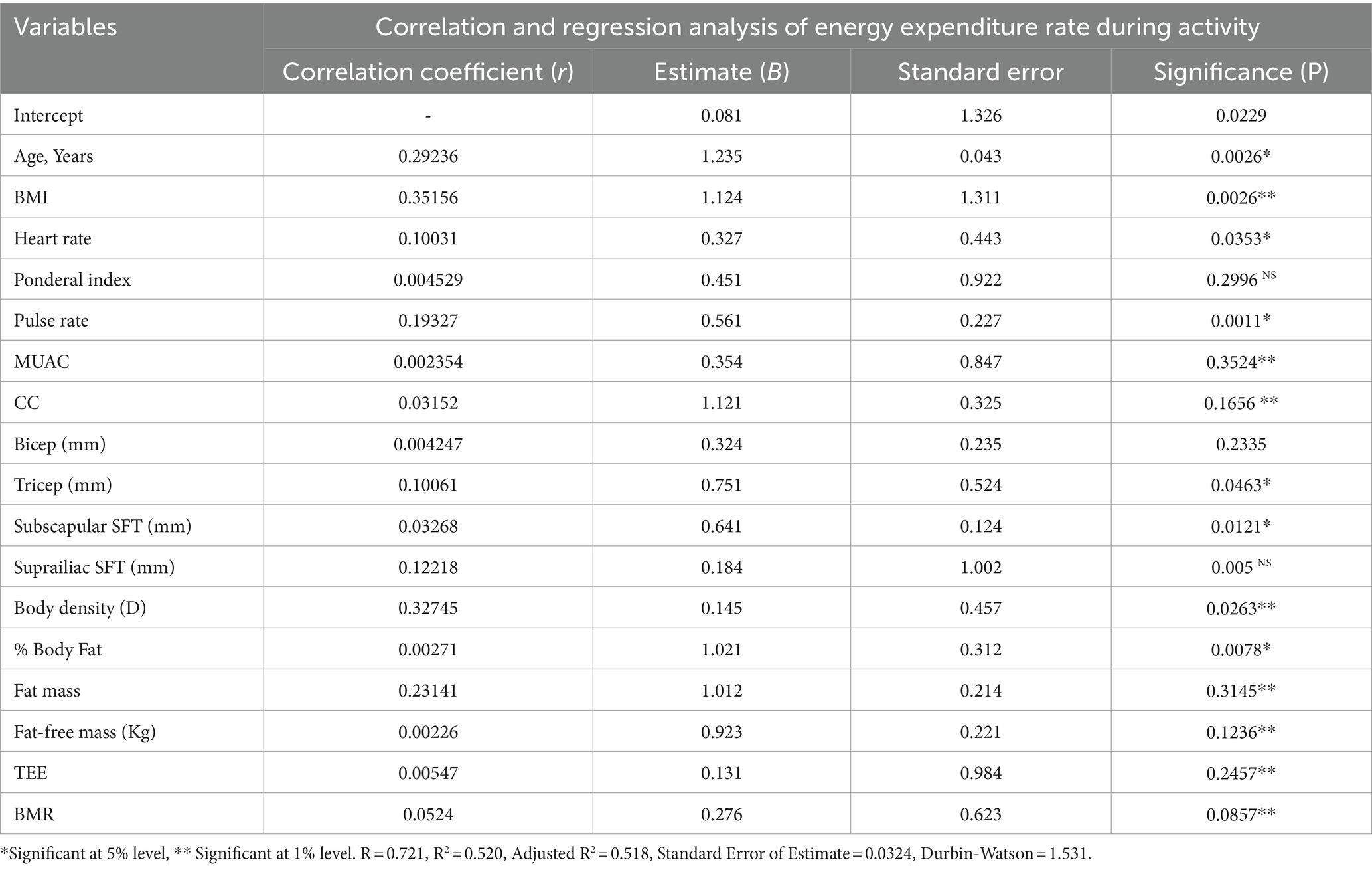
Table 6. Determinants of drudgery mapping in relation to energy expenditure rate in crop production practices.
4 Conclusion
Despite the intensive involvement in most arduous agriculture and allied activities, women’s work is not recognized in monetary terms, her achievements are not mechanized, and work-related tools and equipment are not made as per her anthropometric and reach measurements. In the present study, data indicating musculoskeletal disorders were analyzed by ergonomics assessment of postural and biomechanical assessments using the Human Physical Drudgery Index (HPDI), resulting in the maximum drudgery reflecting very high risk in transplanting, threshing, load carrying, and harvesting. For physiological ergonomics quantifications, the most drudgery-prone activities in the rice-wheat production system, i.e., transplanting, harvesting, threshing and post-harvest, and load carrying and was evaluated, and it was found that drudgery is caused by different activities with reflects working energy expenditure rate ranging from ~7.00 to 12.00 (kJ/min) and TCCW ~331.00 to 524.00.
Human energy can be saved or conserved by using small tools, implements, and types of machinery developed to perform various agricultural operations. The drudgery-prone activities performed by them should need immediate attention so that the physiological and muscular stresses of the said activities for farm women are reduced, the efficiency of the work is ensured, and the safety and health status of women are promoted. A major obstacle arising from such dependency is a mass reduction in human farm power. Agricultural labor-saving technologies have often been developed with a focus on men’s work and needs and have overlooked or neglected women-led production processes (in rice-wheat production practices) and activities associated specifically with women’s work. There is insufficient technology adapted for women that considers the nature of their work, their time use, their physique, and the social and cultural context they live in. Therefore, research needs to focus on the following:
i. Identification of technologies adapted for women and women-specific priorities;
ii. Understanding when women’s labor peaks occur, what type of labor-saving technologies they need, and how these can contribute to reducing work burden; and
iii. Determining how these technologies can be introduced and what measures and support are needed for their adoption.
iv. Tailor-made women-friendly prototypes must be replicated by the manufacturers so that an adequate amount of implements can be produced to cater to the needs of the women workforce.
5 Implications of the study
Agricultural workers face health hazards and risks, and women farmers often lack the education and necessary information to mitigate drudgery. In the research findings, a systematic strategy is suggested with the intention of increasing awareness of the related risk factors and designing gender-friendly ergonomics equipment and farm machinery. The identification of the risk factors pertaining to drudgery mapping, the determination of the root causes, and the development, implementation, and evaluation of ergonomic interventions for women folks are mandatory. The results clearly indicate the importance of ergonomic and drudgery-related issues of women in farm mechanization as due attention to increased productivity by enhancing efficiency and reduced fatigue and drudgery involved in agricultural operations. The results of the study benefit various agro-industries and agricultural engineers who are responsible for designing, manufacturing, and validating farm tools and types of machinery. The present study is also helpful to different agricultural universities and students for conducting location-specific trials of farm equipment, types of machinery, and evaluation of agricultural activities on occupational hazards and drudgery for generating the nationwide ergonomics database for agricultural operations pertaining to various cropping patterns.
Data availability statement
The original contributions presented in the study are included in the article/supplementary material, further inquiries can be directed to the corresponding authors.
Author contributions
PJ: Conceptualization, Data curation, Formal Analysis, Investigation, Methodology, Writing – original draft. GM: Conceptualization, Writing – original draft, Writing – review & editing. RJ: Methodology, Writing – review & editing. Satyapriya: Supervision, Visualization, Writing – review & editing. RS: Data curation, Validation, Writing – review & editing. SiB: Formal Analysis, Methodology, Software, Writing – review & editing. SubS: Formal Analysis, Investigation, Writing – review & editing. SuB: Validation, Writing – original draft. SujS: Formal Analysis, Software, Writing – review & editing. RB: Supervision, Visualization, Writing – review & editing.
Funding
The author(s) declare that no financial support was received for the research, authorship, and/or publication of this article.
Acknowledgments
The authors acknowledge the Indian Agricultural Research Institute (ICAR), New Delhi, India, for the support and necessary facilities.
Conflict of interest
The authors declare that the research was conducted in the absence of any commercial or financial relationships that could be construed as a potential conflict of interest.
Publisher’s note
All claims expressed in this article are solely those of the authors and do not necessarily represent those of their affiliated organizations, or those of the publisher, the editors and the reviewers. Any product that may be evaluated in this article, or claim that may be made by its manufacturer, is not guaranteed or endorsed by the publisher.
References
Ahmad, N., Joshi, P., Sharma, N., Dabas, J., Kumbhare, N. V., Punitha, P., et al. (2021). Relative performance and Outscaling of basmati varieties in northern India. J. Commun. Mobil. Sustain. Dev. 16, 267–270. Available at: https://www.researchgate.net/publication/357478265_Relative_Performance_and_Outscaling_of_Basmati_Varieties_in_Northern_India.
Anitha, R. O., Singh, B. K., and Afifa, J. (2019). An evaluation of drudgery reducing agricultural technologies developed for farm women. Int. J. Agricult. Sci. Res. 9, 35–42. doi: 10.24247/ijasrapr20195
Anusha, M., and Mehta, A. K. (2021). Drudgery reduction through ergonomic evaluation of women farm workers using local sickle and serrated sickle during harvesting in wheat crop of Udaipur District. Int. J. Curr. Microbiol. App. Sci. 10, 1075–1084. doi: 10.20546/ijcmas.2021.1001.130
Awasthi, N., Singh, A. K., Yadav, C. K., and Kumar, A. (2018). Performance analysis of Conoweeder to combat drudgery involved in weeding of paddy. Pharma Innov. J. 7, 251–255. Available at: https://www.thepharmajournal.com/archives/2018/vol7issue7/PartE/7-6-105-855.pdf.
Badodiya, S. K., Gour, C. L., and Chourasia, K. (2014). Analytical study on occupational health hazards among tribal farm women in operations of different agricultural activities. Indian J. Sci. Technol. 10, 115–119.
Banjara, T. R., Bohra, J. S., Kumar, S., Ram, A., and Pal, V. (2021). Diversification of rice–wheat cropping system improves growth, productivity and energetics of rice in the indo-Gangetic Plains of India. Agric. Res. 11, 48–57. doi: 10.1007/s40003-020-00533-9
Boocock, M. G., Jackson, J. A., Burton, A. K., and Tillotson, K. M. (1994). Continuous measurement of lumber spinal posture using flexible electrogonionmeters. Ergonomics 37, 175–185. doi: 10.1080/00140139408963636
Cathy, R. F., Bharati, P., Vijesh, V., Roeven, L., and Badstue, L. (2022). Caste-gender inter-sectionalities in wheat-growing communities in Madhya Pradesh, India. Gender Technol. Dev. 26, 28–57. doi: 10.1080/09718524.2022.2034096
Dasa, B., and Gangopadhyay, S. (2011). An ergonomics evaluation of posture related discomfort and occupational health problems among rice farmers. Occup. Ergon. 10, 25–38. doi: 10.3233/OER-2011-0190
Dubey, R., Gupta, R., and Kaur, J. G. (2019). Occupational health risk among the females working in wheat crop fields. Int. J. Home Sci. 5, 08–11. Available at: https://www.homesciencejournal.com/archives/2019/vol5issue1/PartA/4-3-62-646.pdf.
Gautam, A., Jogdand, S. V., and Omprabha, (2020). Ergonomic study of farm women for selected agricultural implements. J. Pharmacognosy Phytochem. 9, 298–300. Available at: https://www.phytojournal.com/archives/2020.v9.i1.10438/ergonomic-study-of-farm-women-for-selected-agricultural-implements.
Hoy, D., March, L., Brooks, P., Blyth, F., Woolf, A., Bain, C., et al. (2014). The global burden of low back pain: estimates from the global burden of disease study. Ann. Rheum. Dis. 73, 968–974. doi: 10.1136/annrheumdis-2013-204428
Jadhav, A. V. (2020). Measuring the drudgery and time-poverty of rural women – a pilot study from rural Rajasthan. Indian J. Occup. Environ. Med. 24, 142–147. doi: 10.4103/ijoem.IJOEM_151_19
Jafry, T. (2016). Making the case for gender sensitive climate policy: lessons from South Asia/IGP. Int. J. Clim. Change Strat. Manag. 8, 559–577. doi: 10.1108/IJCCSM-04-2015-0049
Joshi, P., Kumar, A., Bisht, K., and Singh, O. P. (2020). Ergonomics assessment of drudgery in wheat production system. Indian J. Exten. Educ. 56, 155–159. doi: 10.5958/2454-552X.2020.00069.9
Joshi, P., Sharma, N., Kumar, A., Dabas, J., Ahmad, N., Sahu, S., et al. (2018). Assessment of drudgery in Paddy cultivation among women workers and technological gaps in the National Capital Region of Delhi. J. Commun. Mobiliz. Sustain. Dev. 13, 227–232. Available at: https://www.researchgate.net/publication/342657735_Assessment_of_Drudgery_in_Paddy_Cultivation_among_Women_Workers_and_Technological_Gaps_in_the_National_Capital_Region_of_Delhi.
Jyotsana, K. R., Singh, K., and Mehta, M. (2005). Ergonomic evaluation of rural women while performing wheat harvesting activity. J. Human Ecol. 18, 309–311. doi: 10.1080/09709274.2005.11905847
Kamarudin, N. H., Ahmad, S. A., Hassan, M. K., Mohd Yusuff, R., and Md Dawal, S. Z. (2013). A review of the NIOSH lifting equation and ergonomics analysis. Advanced engineering. Forum 10, 214–219. doi: 10.4028/www.scientific.net/AEF.10.214
Karki, I., Joshi, P., Dhingra, D., and Shenoy, S. (2012). Physiological assessment of Nilgiri women involved in economic activities. J. Hum. Ecol. 38, 43–47. doi: 10.1080/09709274.2012.11906473
Klasen, S., and Lamanna, F. (2009). The impact of gender inequality in education and employment on economic growth: new evidence for a panel of countries. Fem. Econ. 15, 91–132. doi: 10.1080/13545700902893106
Kuiper, J. I., Burdorf, A., Verbeek, J., Dresen, M., Van, D., and Viikari, J. (1999). Epidemiologic evidence on manual materials handling as a risk factor for back disorders: a systematic review. Int. J. Ind. Ergon. 24, 389–404. doi: 10.1016/S0169-8141(99)00006-2
Kumar, B., Gowda, T. P., and Khandekar, N. (2011). Time utilization pattern and drudgery of horticultural crops. Int. J. Eng. Manag. Sci. 2, 93–96. Available at: http://www.scienceandnature.org/IJEMS/IJEMS-Vol2(2)-Apr2011/IJEMS_V2(2)5.pdf.
Kumari, A. R. (2015). Role of farm women in agricultural activities. Agricult. Update 10, 31–35. doi: 10.15740/HAS/AU/10.1/31-35
Kundu, T., Kumar, M., Joshi, P., Bharadwaj, A., Marwaha, S., and Pal, S. (2021). Development and validation of mobile based decision support system for human physical drudgery index (HPDI). Indian J. Agric. Sci. 91, 1165–1167. doi: 10.56093/ijas.v91i8.115805
Lalik, R., Sharma, S., Idris, M., Singh, A. K., Singh, S. S., and Bhatt, B. P. (2014). Integration of conservation agriculture with best management practices for improving system performance of the rice–wheat rotation in the eastern indo-Gangetic Plains of India. Agric. Ecosyst. Environ. 195, 68–82. doi: 10.1016/j.agee.2014.06.001
Larson, D., and Hannihen, (1995). Surface electromyography: research clinical and sports applications. Indian J. Physio Allied Sci. 49, 5–9.
Maiti, R., and Ray, G. G. (2004). Manual lifting load limit equation for adult Indian women workers based on physiological criteria. Ergonomics 47, 59–74. doi: 10.1080/00140130310001611116
Murthy, M. R. K., and Bindu, M. S. (2013). Empowering rural women and occupational health hazards of farm women engaged in different activities of agriculture in Andhra Pradesh, India. Indian J. Agricult. Sci. 2, 2250–3994.
Nag, P. K., and Chatterjee, S. K. (1981). Physiological reactions of female workers in Indian agricultural work. Hum. Factors 23, 607–614. doi: 10.1177/001872088102300510
Nag, P. K., and Nag, A. (2004). Drudgery, accidents and injuries in Indian agriculture. Ind. Health 42, 149–162. doi: 10.2486/indhealth.42.149
National Institute for Occupational Safety and Health (2001). Simple solutions: Ergonomics for farm workers. Report no. 2001–111, 153. Washington, DC: National Academy Press.
National Research Council and Institute of Medicine (2001). Musculoskeletal disorders and the work place: Low back and upper extremities. National Academy Press: Washington, DC.
Nawi, N. M., Yahya, A., Chen, G., Bockari, S. M., and Maraseni, T. N. (2012). Human energy expenditure in lowland rice cultivation in Malaysia. J. Agric. Saf. Health 18, 45–56. doi: 10.13031/2013.41232
Nayak, J., Mhatre, C., and Rout, P. K. (2022). Technological empowerment and drudgery reduction of farm women. Vigyan Varta. 3, 95–100.
Ojha, P., and Kwatra, S. (2012). An ergonomic study on human drudgery and musculoskeletal disorders by rice transplanting. Stud. Home Community Sci. 6, 15–20. doi: 10.1080/09737189.2012.11885351
Prabhakar, S., Mehta, C. R., Agrawal, K. N., Potdar, R. R., Manoj, K., and Karan, S. (2023). Approach for ergonomic assessment of self-propelled combine harvester seats based on anthropometric body dimensions. Int. J. Occup. Saf. Ergon. 29, 282–293. doi: 10.1080/10803548.2022.2038460
Sharma, N., Joshi, P., Ahmad, N., Dabas, J., Chakravorty, S., Kumbhare, N. V., et al. (2022). Quantification of informal spread of high yielding wheat (Triticum aestivum) seeds among farmers of National Capital Region. Indian J. Agric. Sci. 92, 1091–1095. doi: 10.56093/ijas.v92i8.112096
Singh, S. P. (2012). Physiological workload of farm women while evaluating sickles for paddy harvesting. Agric. Eng. Int. 14, 82–88. Available at: https://cigrjournal.org/index.php/Ejounral/article/view/1540.
Singh, S. P., Gite, L. P., Majumder, J., and Agarwal, N. (2008). Aerobic capacity of farm women using sub-maximal exercise technique on tread mill. Agricult. Eng. Int. 8, 213–220. Available at: https://www.researchgate.net/publication/201295800_Aerobic_Capacity_of_Indian_Farm_Women_Using_Sub-maximal_Exercise_Technique_on_Tread_Mill.
Keywords: drudgery, ergonomics, rice-wheat production system, postural assessment, biomechanical assessment
Citation: Joshi P, Mahra GS, Jethi R, Satyapriya, Singh R, Bishnoi S, Sahu S, Barua S, Sarkar S and Burman RR (2024) Ergonomics assessment of drudgery in rice-wheat production system in India: a case study of women farmers. Front. Sustain. Food Syst. 8:1346980. doi: 10.3389/fsufs.2024.1346980
Edited by:
Benoit Dedieu, Institut National de recherche pour l’agriculture, l’alimentation et l’environnement (INRAE), FranceReviewed by:
Abhijeet Jadhav, National Institute of Virology (ICMR), IndiaSouvik Ghosh, Visva-Bharati University, India
Shivendra Kashyap, G. B. Pant University of Agriculture and Technology, India
Copyright © 2024 Joshi, Mahra, Jethi, Satyapriya, Singh, Bishnoi, Sahu, Barua, Sarkar and Burman. This is an open-access article distributed under the terms of the Creative Commons Attribution License (CC BY). The use, distribution or reproduction in other forums is permitted, provided the original author(s) and the copyright owner(s) are credited and that the original publication in this journal is cited, in accordance with accepted academic practice. No use, distribution or reproduction is permitted which does not comply with these terms.
*Correspondence: Pratibha Joshi, cHJhdGlqb3NoMTJAZ21haWwuY29t; Girijesh Singh Mahra, Z2lyaWplc2htYWhyYTIyQGdtYWlsLmNvbQ==; Rahul Singh, cmFodWxpYXJpQGdtYWlsLmNvbQ==
 Pratibha Joshi1*
Pratibha Joshi1* Girijesh Singh Mahra
Girijesh Singh Mahra Rahul Singh
Rahul Singh Sitaram Bishnoi
Sitaram Bishnoi Subhashree Sahu
Subhashree Sahu

